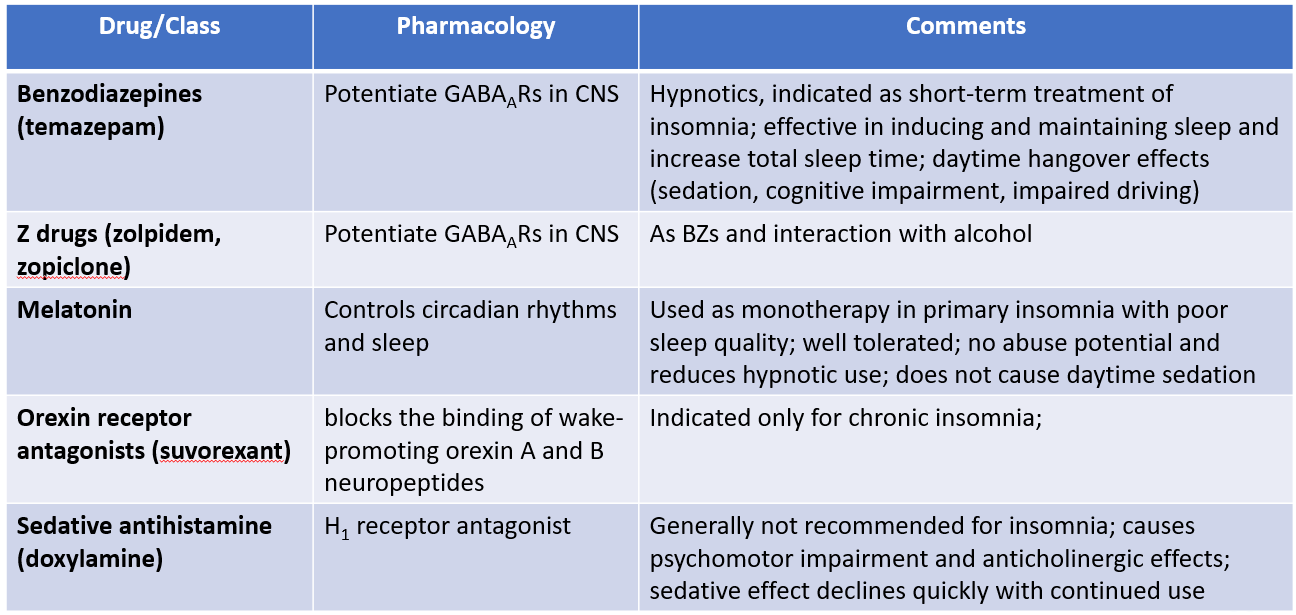11.3 Drugs for Sleep Disorders
Sleep Disorders – Insomnia
Individuals with normal sleep patterns sleep up to one-third of their lives and spend more time sleeping than in any other single activity. Sleep is necessary to enable one to maintain wakefulness and good health. Disruption of normal sleep is a major cause of societal morbidity, lost productivity, and reduced quality of life. Sleep disturbances may contribute to the development and progression of comorbid medical conditions. Some common types of sleep disorders include insomnia, narcolepsy, restless leg syndrome, obstructive sleep apnoea and parasomnia.
Insomnia
Chronic insomnia is when a patient can’t sleep (initiation of sleep) or has complaints about the duration or quality of the sleep (maintenance of sleep) for at least 3 days a week and is persistent for weeks to months.
The prevalence of insomnia tends to increase with age, and women are about 1.5 times more likely to experience it compared to men. Persistent insomnia affects nearly one-third of individuals over the age of 65. Around 10% of adults suffer from chronic insomnia, with a slightly higher number experiencing short-term insomnia.
For insomnia, a person must have trouble falling asleep, staying asleep, or waking up too early at least three times per week for a period of at least three months. Approximately 40% of individuals with psychiatric disorders also suffer from insomnia. The condition is often triggered by acute stress but usually improves once the stress is alleviated. Various medical conditions like pain, thyroid issues, asthma, and gastroesophageal reflux, as well as medications such as selective serotonin reuptake inhibitors (SSRIs), steroids, stimulants, and β-agonists, can also contribute to insomnia.
Pharmacotherapy for Insomnia
Sleep hygiene is very important for improved quality of sleep. However, Cognitive behaviour therapy (CBT) is initially recommended followed by treatment of comorbidities and short-term use of drugs that promote sleep such as sedatives and hypnotics. The pharmacotherapy is only indicated for:
The common drugs used to treat insomnia are:
- Benzodiazepines: Short-acting benzodiazepines, such as lorazepam and temazepam, are effective for managing insomnia due to their minimal residual effects. Their short half-life allows for longer periods without the drug, which helps mitigate the risk of developing tolerance. Conversely, diazepam, which has a longer duration of action, is suitable for treating insomnia linked to anxiety experienced during the day.
- Z-drugs: Zolpidem, and zopiclone, although chemically different, are short-acting sleep aids that target the benzodiazepine binding site on GABAA receptors featuring the α1 subunit. They do not possess significant anxiolytic properties. Eszopiclone is the active form of zopiclone.
- Melatonin receptor agonist: Melatonin acts as an agonist at the MT1 and MT2 receptors. Melatonin is particularly effective for treating insomnia in older adults, children with autism, and individuals who are completely blind.
- Orexin receptor antagonists: Suvorexant inhibits the OX1 and OX2 receptors, which are involved in the action of orexins, neuropeptides in the central nervous system that play a crucial role in regulating sleep-wake cycles. Since orexin levels are typically elevated during the day and reduced at night, this medication helps decrease wakefulness.
Drugs – refer to zolpidem and zopiclone
Zolpidem and zopiclone are imidazopyridine derivatives. They potentiate the inhibitory effects of GABA. These drugs are agonists at the GABAA receptor-ionophore complex and are more selective at the α subunit of GABAA receptor. They typically bind to the α1 subunit of the GABAA receptor. They are sedative/hypnotics indicated for the short-term treatment of insomnia.
Zolpidem and zopiclone have been related to adverse effects such as sleepwalking and related risky behaviours. They are not indicated for treatment of anxiety disorders and are not used as anticonvulsants or muscle relaxants.
Melatonin
Melatonin, chemically known as N-acetyl-5-methoxytryptamine, is a hormone produced naturally in the body and shares a chemical relationship with serotonin (5-HT). This hormone is released by the pineal gland during the night and interacts with the melatonin receptors, MT1 and MT2, located in the anterior hypothalamus, thereby promoting feelings of sleepiness. Additionally, melatonin can assist in resetting the body’s internal circadian rhythm.
It is classified as a Schedule 3 medication, approved for short-term use as a standalone treatment for primary insomnia in individuals aged 55 and older. Recently, its application has expanded to include managing insomnia in children and adolescents aged 2 to 18 years with autism spectrum disorder, particularly when traditional sleep hygiene strategies have proven ineffective.
Possible side effects may include nausea, joint pain, back pain, headaches, lowered body temperature, and feelings akin to a hangover. Melatonin is available in modified-release tablets up to 2 mg, as well as 1 mg and 5 mg prolonged-release tablets designed for use in children and adolescents.
Comparison of drugs used in insomnia
👁️🎧 Listen & Watch the Lecture on Drugs for Insomnia (16 minutes)
Lecture Material
💡Learning Activity
COMMONWEALTH OF AUSTRALIA Copyright Regulations 1969 WARNING This material has been reproduced and communicated to you by or on behalf of James Cook University in accordance with section 113P of the Copyright Act 1969 (Act).
The material in this communication may be subject to copyright under the Act. Any further reproduction or communication of this material by you may be the subject of copyright protection under the Act. Do not remove this notice.

